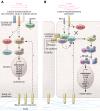Nck1 is a critical adaptor between proatherogenic blood flow, inflammation, and atherosclerosis
- PMID: 32657777
- PMCID: PMC7410038
- DOI: 10.1172/JCI138536
Nck1 is a critical adaptor between proatherogenic blood flow, inflammation, and atherosclerosis
Abstract
Atherosclerosis is an inflammatory condition of the arteries that has profound incidence and increasing prevalence. Although endothelial cells detect changes in blood flow, how endothelial activation contributes to atherogenic inflammation is not well understood. In this issue of the JCI, Alfaidi et al. used mouse models to explore flow-induced endothelial activation. The authors revealed a role for Nck1 and a specific activator of the innate immune response, the downstream interleukin receptor-associated kinase-1 (IRAK-1) in NF-κB-mediated inflammation and atherosclerosis susceptibility. These results link disturbed blood flow to NF-κB-mediated inflammation, which promotes atherosclerosis, and provide Nck1 as a potential target for the treatment of atherosclerosis.
Conflict of interest statement
Figures

Comment on
-
Selective role of Nck1 in atherogenic inflammation and plaque formation.J Clin Invest. 2020 Aug 3;130(8):4331-4347. doi: 10.1172/JCI135552. J Clin Invest. 2020. PMID: 32427580 Free PMC article.

